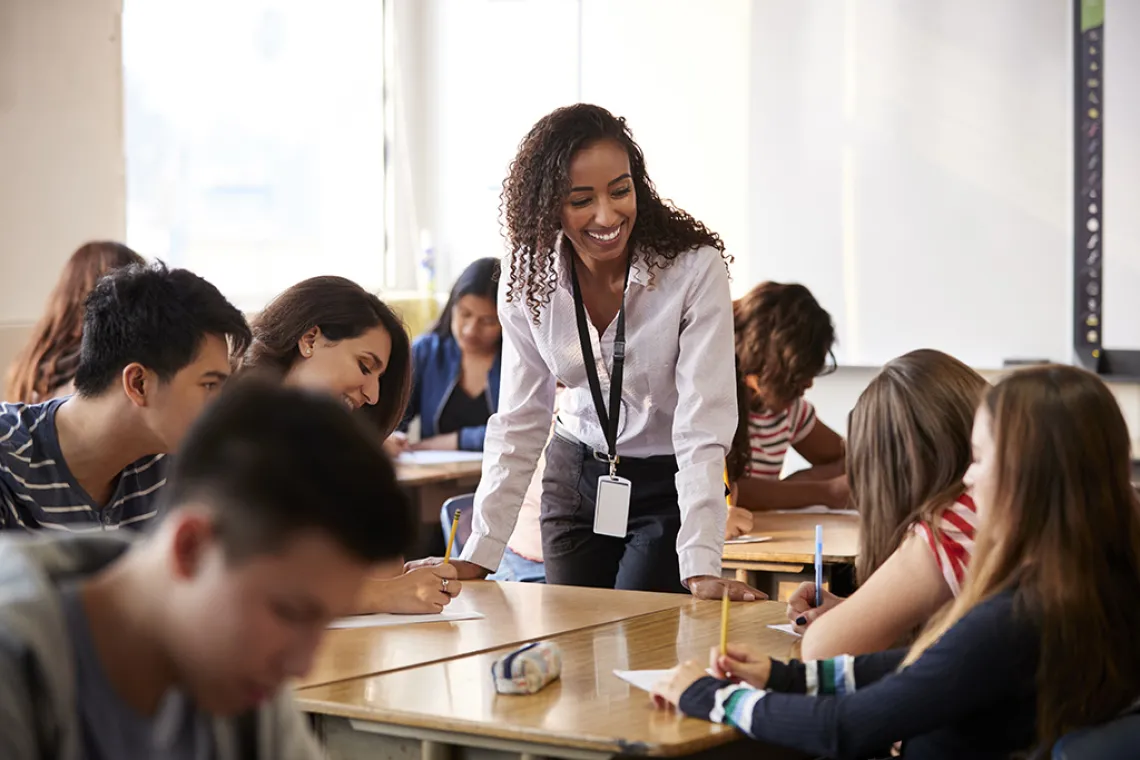Learning to Teach

By Luke Wink-Moran
Photo Credit: ©Monkey Business - stock.adobe.com
Imagine standing in front of a classroom for the first time—chalk, whiteboard marker, or 300-megawatt laser pointer in hand—as the students settle into their seats, flip open their notebooks, and look up, ready to learn.
It’s at this moment that some important questions might occur to new teachers. Questions like, “What do I do now? Should I begin with group work? Focus on icebreakers and community building or on rules and the syllabus?” In essence, the teacher discovers the importance of that nuanced and complicated key to classroom success—pedagogy.
Graduate students and postdocs have this experience every year as they step into roles as teaching assistants in their departments, but they don’t have to face it unprepared. The University of Arizona has many resources for students and faculty who want to teach and teach well. There is support from Faculty Learning Communities (FLCs), classes on pedagogy, workshops on mitigating unconscious bias in the classroom, research on best practices in active-learning, and much more.
To understand what the learning programs entail and who might benefit from them, I spoke with Dr. Kristin Winet, program administrator for UArizona’s Center for the Integration of Research, Teaching, and Learning (CIRTL) and lecturer in the Writing Program, and Steven Petritis, a Ph.D. candidate in the Department of Chemistry and Biochemistry.
Petritis still remembers the moment that he decided to pursue teaching, “I was in a lab,” he said, “focused on organic chemistry, my head—safely—in a fume hood. But I was contributing to a very small field of people, and I wanted to make a bigger difference than that.” Petritis switched from the laboratory to a chemistry education research focus and took his first step into the graduate education community by joining an FLC.
“I always encourage students to start with FLC’s,” said Dr. Winet. “They’re very informal, open to anyone with an interest in teaching, and they’re interdisciplinary.” “You’re just having these low-key conversations with faculty and staff from all across campus and from different disciplines,” Petritis explained. “All coming together to discuss similar topics and how they relate to teaching in their own fields.”
Petritis, who participated in Dr. Winet’s Geeky Pedagogy FLC for early-career faculty last spring, was invited to co-facilitate it this semester after showing an interest in leading discussions on teaching. He has also joined CIRTL, which helps prepare graduate students and post-docs in STEM and other disciplines for future teaching positions in higher education.
“We know students learn best when they’re doing hands-on active learning,” Dr. Winet noted. “So we bring some of those ideas to STEM graduate students and post-docs who want to make teaching a part of their careers.” CIRTL also helps students conduct in-class research, find teaching mentors, and publish in relevant fields that will prepare them for teaching positions in higher education.
But CIRTL isn’t the only option for students and TAs hoping to become better teachers. Petritis has also taken classes for the Certificate in College Teaching (CCT) program with the Office of Instruction and Assessment (OIA). The OIA provides resources and support in everything from pedagogical planning and curricular design to instructional technologies, multimedia and website design, and course and student assessment. And that only scratches the surfaces of OIA’s resources.
For new TAs seeking a community of other TAs, the Graduate Teaching Assistant Training (TAMP) program offers opportunities to build classroom leadership skills through mentorship, peer observation, and TA learning communities. With support from Graduate College Dean Andrew Carnie, Dr. Amy Graham spearheaded the development of the TAMP program.
Another valuable aid for TAs is the “Academic Instruction Resources” page that is maintained by the Pandemic Academic Coordination team (PAC). Assisting teachers with navigating the pandemic, PAC provides instructional guidelines and up-to date information about the university’s response to COVID 19.
While all these resources help TAs, graduate students aren’t the only ones who stand to benefit from them. As Petritis observed, whether learning about pedagogy is graduate students’ “true passion or a career they’re interested in, it is not only going to benefit them but—and this is the reason I and so many others do it—it also really helps the undergraduates.”

